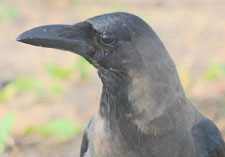Birds are the only animal form found in any climatic condition, anywhere in the world. They have no geographic barriers.
Colombo, 50 years ago used to have large populations of crows, feral pigeons and house sparrows. The house sparrow and the pigeon population declined with the closure of the granaries in the city. But not the crows.
The crow population multiplied in such numbers that one had to walk under an umbrella in the parks and the tree lined avenues in the evenings. Day time was no better, the writer as a school boy could remember the “crow scarer” at the Fort Railway Station who carried a device that would give out the sound of cannon-fire every now and then to scare away the crows on the steel trusses of the station roof. All this was to protect the people from their droppings.
The Colombo Crows (Kolamba Kaka) were the problem birds in the 60’s and 70’s where even projects to poison them were discussed in the boardrooms of the city fathers. They have since survived the discussions and time, by bringing down their own numbers to tolerable levels. Today, we do not see them as a nuisance anymore.
Animals including crows are found to be opportunistic. They would exploit a situation for their benefit. Crows being omnivorous thrived on the freely available garbage and waste during these periods. If one goes down memory lane there were times when the city garbage was a sorry sight throughout the day. The crow population increased immensely scavenging on the garbage. The improved disposal of city waste has had an impact on the food source resulting in reduced breeding. This type of control in population with the availability of food resources is instinctive in the animal kingdom.
The crow is said to pair for life just like us, and one can see them grooming each other lovingly. The male is always in close proximity to the shabby nest while the female sits on the eggs. They are very aggressive during this period and attack any intruders to the nest. During non-breeding periods, they prefer to roost in the colony where they start assembling at fading light. The night temperature in cities is a few degrees warmer than the surrounding areas, and the mass gathering of birds keeps the roost warm. This increased temperature is favourable to start activities fairly early in the morning.
Most roosting birds require warmth from the morning sun for effective blood circulation, to become active. Birds are thought to have poor eyesight at night, and sleeping in the city gives the advantage of being safe from predators. The illuminated city below the roost is advantageous to fly to in an emergency.
On the other hand these communal roosts act as social gatherings where birds challenge each other, find potential mates, and communicate in one way or another, of available feeding grounds etc. Many of these nightly inhabitants in a communal roost are young non-breeders.
This explains why the destruction of birds in these roosts has not been successful in bringing down the populations. If you eradicate every bird in the roost, you would still leave the breeding population virtually untouched, and these breeding birds are quite successful in replacing the lost population in a very short period of time.
It would be interesting to analyze the control of the crow with relation to our own changes that have come about in the recent past.
The outdoor fish and meat stalls are now indoor supermarkets where meat and fish are pre-dressed or processed for sale; thereby the waste matter is minimal. The bio-degradable garbage is either turned into compost in small home units or delivered to the collecting trucks in an organized form instead of being dumped on the wayside.
The Crow is the biological indicator in the control of garbage in the city; the cleaner the city, the fewer the number of crows.
The efficiency of these biological indicators is evident at Horton Plains. There were no crows in Horton Plains in the 60’s and 70’s. But ever since it was declared a National Park, became a holiday destination and every nook and cranny filled with garbage, things have changed. There is now a crow up there eagerly waiting for you.
(The writer is a Life Member of the Field Ornithology Group of Sri Lanka of the Department of Zoology in the University of Colombo) |


